[ad_1]
On this piece, Hannes Hase, a Knowledge Scientist at Bayes Esports, breaks down how League of Legends steadiness patches impression the meta and information surrounding a match.
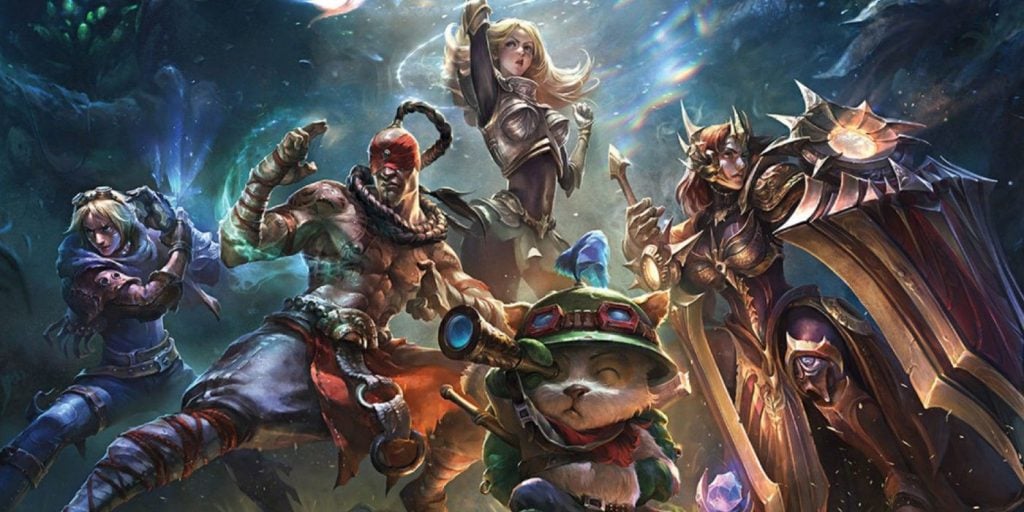
Disclaimer: This can be a sponsored piece from Bayes Esports
In a recreation as complicated as League of Legends, holding champion energy, merchandise stats and common interactions in steadiness are key to maintain the group round it comfortable. The wrestle right here is that every time new components are launched into the sport, it’s laborious to completely estimate their impression, resulting in a needed readjustment afterwards. For this, Riot releases balancing patches each few weeks, attempting to amend undesirable and sudden over-tuned features of the sport.
As quickly as a brand new patch is introduced, gamers all all over the world begin searching for new methods of exploiting the potential penalties of the launched adjustments. This results in adjustments within the meta. Meta, or ‘only ways out there’, is a time period recurrently used within the gaming world to explain the go-to picks or methods at a given time. It isn’t obligatory to observe, and gamers have had success with off-meta methods, but following the meta often is the most secure path to victory.

Meta is fluid and relies on a number of in-game elements like gadgets, adjustments to the map, new champions and changes to impartial aims. It’s the method and understanding the participant base has of the sport at a given house and time. Thus, when following worldwide tournaments, we will see how meta shifts because the event progresses and the way drafted staff compositions are fully totally different in the direction of the finals when in comparison with play-in levels.
Probably the most drastic adjustments are often launched by Riot initially of every 12 months and season. Current reworks introduced the introduction of Elemental Dragons and the Rift Herald, a whole redesign of the jungle or the creation of role-specific gadgets. The present season 11 started with a really formidable overhaul of the merchandise system, which largely impacted the sport and meta.
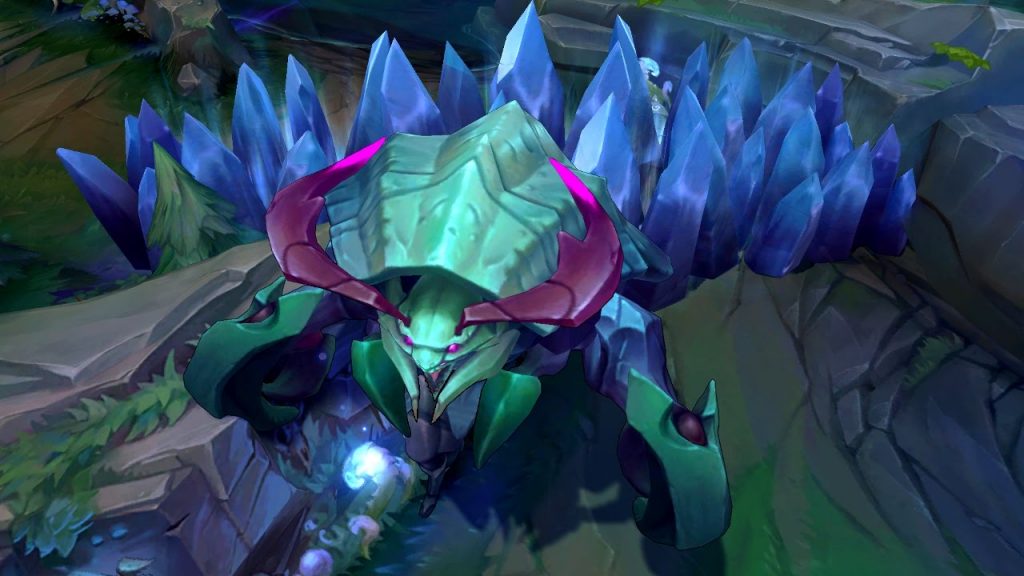
For novice League of Legends gamers all over the place, understanding the meta helps them to climb the ranks in Solo Queue. For skilled gamers, discovering and understanding the meta results in extra victories and perhaps even championship titles. At Bayes Esports, we have to attain an understanding of the meta to remain forward of the curve and have the ability to at all times ship the most effective product attainable to our prospects. Here’s a peek into how we analyse the impression the merchandise system rework had on the understanding of the sport throughout main areas, and the way this affected the preferences {of professional} groups.
For this function, again in February, we constructed a dataset from all Grasp+ Solo Queue matches from the Riot API for patch 11.1 for the three most related areas for the aggressive scene: Europe West (EUW), North America (NA) and Korea (KR). (Be aware: The Riot API doesn’t give entry to the Chinese language Tremendous Server, so we can’t embody this area on this article.)
The intention of this text is to spotlight how totally different areas develop distinctive play types and to showcase the explanation why a recreation patch has an impression on a area’s event efficiency — to not analyse present recreation methods.
Since this research was carried out we’ve seen a number of meta-shifts. Just lately, jungle adjustments have given champions like Morgana and Rumble an sudden precedence and Lee Sin has made his comeback to the Rift, however this time as a laner.
These of you carefully following aggressive League of Legends, will realise with this text how rapidly in-game evaluation turns into outdated.
Regional variations in Solo Queue play
To check the primary variations of Grasp+ Solo Queue play throughout areas, we glance into two parameters — champion reputation and champion success. We name champion reputation the variety of video games the place a selected champion was both picked or banned over the entire variety of video games from that area. As a measure of that champion’s success in that area, we use its win fee. To keep away from area of interest picks, we don’t take into account champions whose joint decide and ban fee are underneath 5 %.
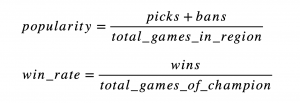
We selected the ten champions for every area that introduced probably the most appreciable reputation distinction in patch 11.1 for every pair of areas and plotted it within the figures under. Every plot exhibits the distinction between two areas, with the recognition distinction on the X-axis the win fee distinction and on the Y-axis. When studying the plots, we will say that for instance, the champion Khazix was round 85 % extra more likely to be picked or banned in Europe than in Korea.
On the identical line, we will say that Khazix was extra more likely to win a recreation in Europe by barely greater than two %.
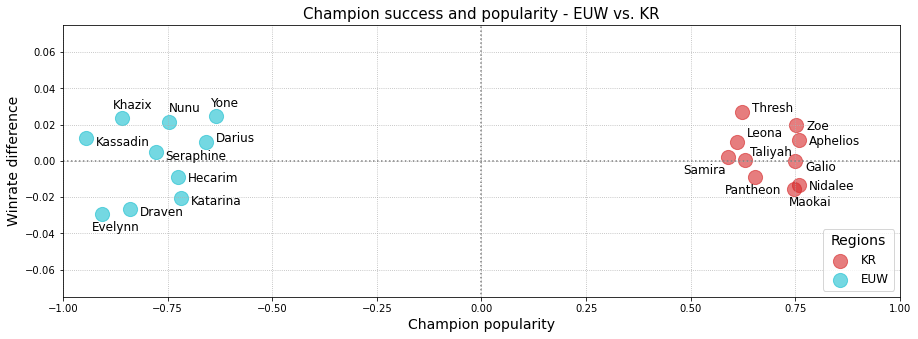
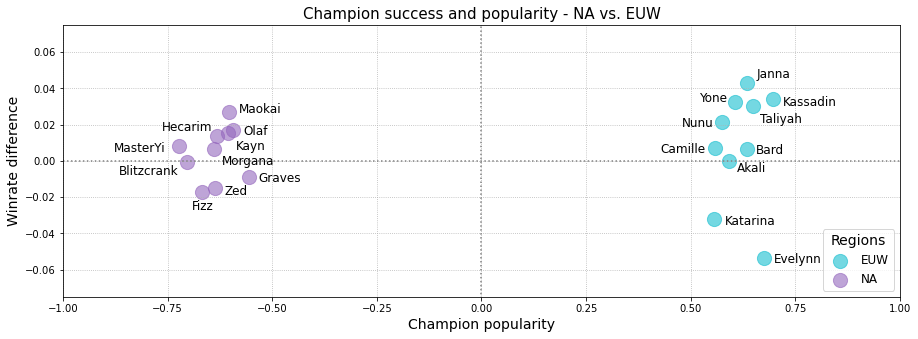
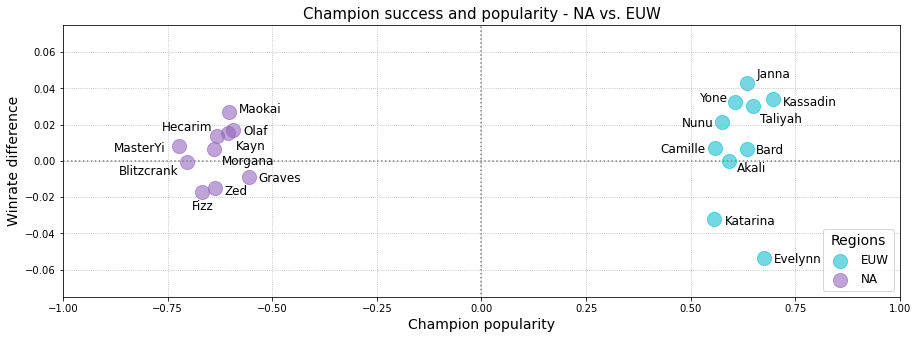
On an total be aware, it’s attention-grabbing that the roles with the very best variance when it comes to champion picks had been jungle and assist. As each these lanes are related in making performs occur for the staff, it’s an preliminary affirmation that totally different areas have totally different approaches to the sport.
We see that each EUW and NA had a better choice for assassins than KR. On the opposite hand, Korea tended extra to love ‘capability energy’-based jungle champions and tank helps.
We additionally discover that Korea’s well-liked champion set repeated itself when evaluating it with EUW and NA. From this perception, we will conclude that the Korean playstyle had a really distinct choice relating to champion precedence.
When wanting on the graphs, there seem like three kinds of champions. The primary sort turns into clear when taking a look at Darius. Darius was extra prevalent in NA and EUW than KR, but he didn’t seem within the comparability between NA and EUW. This behaviour may be defined by Darius being a powerful decide within the meta of western areas, but not prioritised as extremely in KR comparatively talking. Different champions in an analogous scenario had been Seraphine and Draven.
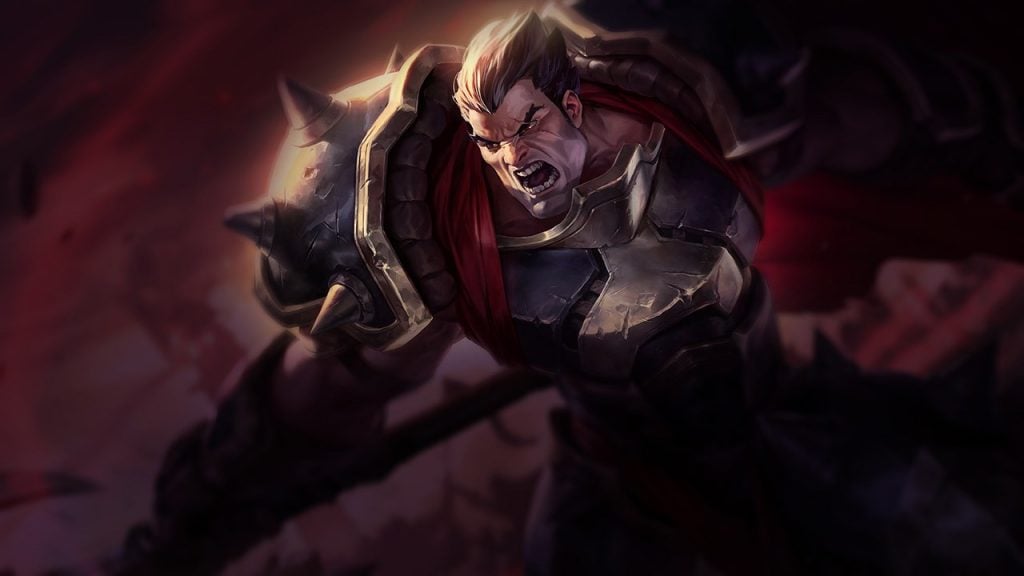
Hecarim exemplifies the second champion sort. This jungle champion gave the impression to be picked extra regularly in EUW than in KR. But, when evaluating EUW with NA, we discover that Hecarim loved even larger precedence in NA. This chain implies that Hecarim had a considerably larger precedence in NA than KR. We see the identical for Taliyah (KR), Evelynn (EUW) or Katarina (EUW).
To explain the third champion sort, we have a look at Pantheon. Pantheon gave the impression to be prioritised larger in KR than each NA and EUW however didn’t seem in EUW vs NA. This doesn’t imply that Pantheon was not related in EUW and NA, however solely that he appeared considerably extra in KR throughout decide and bans. Different champions that fall underneath this class are Nunu and Yone (EUW).
As already talked about earlier than, all different preferences from KR repeated themselves in comparison with EUW and NA. It appears that evidently KR gamers are much less experimental and often decide champions from a narrower champion pool in comparison with the opposite two areas.
We additionally discover champions like Camille, Morgana or Zed, which solely seem as soon as throughout the graphs. This case signifies no clear total tendency, but it surely exhibits the nuances in meta in several areas.
Lastly, it’s important to touch upon excessive precedence champions in patch 11.1, like Kaisa, Jhin, Aatrox or Sett that don’t present up within the plots. This doesn’t imply that they weren’t well-liked.
In roles like AD carry and high lane, the viable champion pool was very restricted. Consequently, their precedence was comparable throughout areas and the brink for an area meta shift was larger, resulting in much less interregional reputation variations on these champions.
Meta in skilled League of Legends
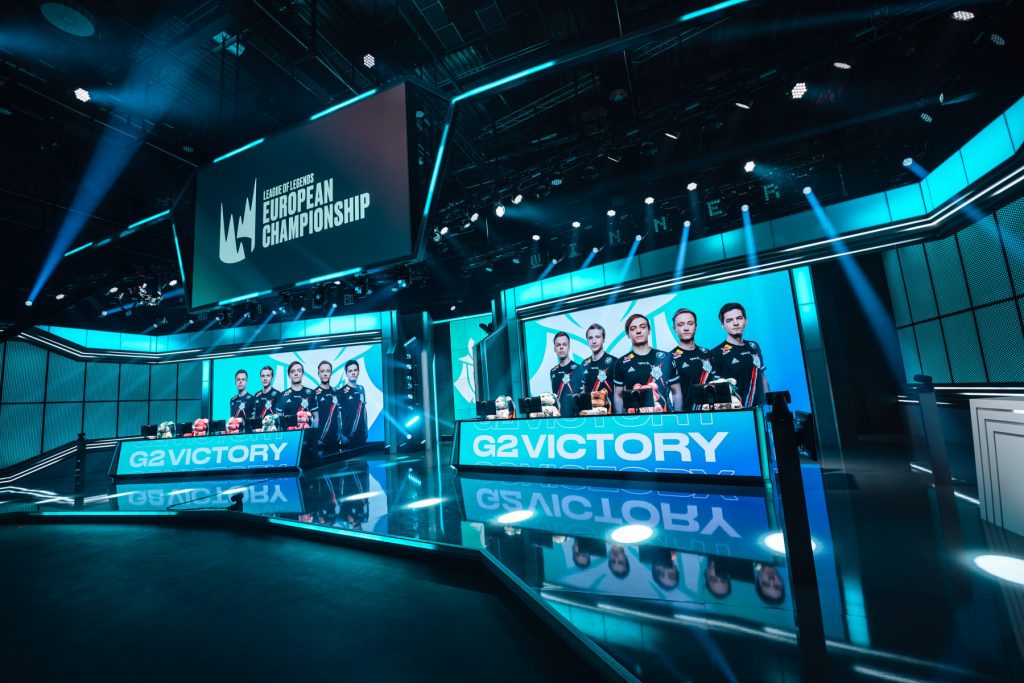
Within the earlier part, we appeared into variations in how gamers method the sport in Solo Queue. Now, to get an concept of how meta is outlined in skilled League of Legends we contacted Christopher ‘Duffman’ Duff, Head Analyst of G2 Esports, probably the most profitable staff for the previous few years in western areas.
What’s the principal distinction between Solo Queue and pro-play relating to
champion prioritisation?
CD: One of many principal variations will probably be how draft works in Solo Queue vs professional play. In professional play, draft is rather more structured. Groups have totally different priorities on who picks how early, who will get bans for instance. In Solo Queue that’s not the case and also you typically decide in your given order. This results in matchups that will by no means occur in a aggressive recreation as you’d both ban them out otherwise you wouldn’t depart your self in a spot to be counter picked.
Out of your expertise, is there an overlap between the area’s Solo Queue meta and the meta in its skilled scene? And if sure, why does this occur?
CD: There may be plenty of overlap when it comes to champions/gadgets which are essentially overtuned/overpowered. When these conditions come up, you’ll usually see the champion picked and banned in each.
How do you put together to face these totally different play types when going to worldwide tournaments?
CD: Relating to worldwide occasions, you principally attempt to scout what groups performed of their dwelling areas and check out to consider the way it could adapt and the place their play-style interacts with yours. It’s not a precise science as a result of typically you must account for 3-4 totally different groups and it may be laborious to arrange for all of them, so I feel the primary focus is on making your self most snug in your method whereas negating methods their play types can assault yours.
When going to worldwide tournaments, what sort of meta has traditionally favoured LEC groups?
CD: Traditionally 1-3-1 break up pushing comps the place solo lanes wish to play on lengthy side-lanes in mid-game favour EU groups. We have now seen in 2018 that even when outmatched in bot lane, in case you have the correct champion pool, you may keep away from preventing “stronger” groups on a degree taking part in area by break up pushing and that is the place Europe has plenty of expertise vs different areas.
Champion presence variations in Solo Queue vs. professional play
With these insights from the skilled analyst scene, we have a look at the variations between the 20 most current champions in pro-play vs. Grasp+ Solo Queue video games worldwide for patch 11.1.

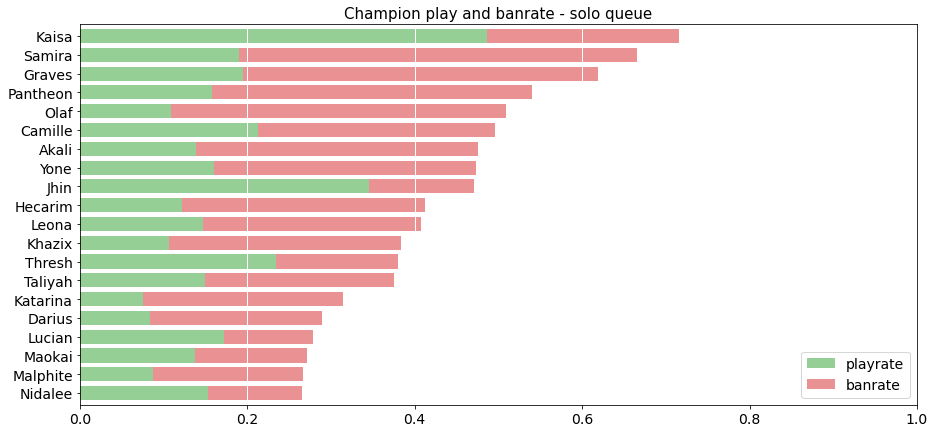
At a primary look, a number of issues pop up. First, the distinction within the magnitudes of joint decide and ban fee of extremely prioritised champions in professional play vs. Solo Queue. Similar to Duffman factors out, drafting in pro-play has a extra coordinated draft section and it exhibits.
One other attention-grabbing discovery from this comparability is that many of the champions with the highest presence usually tend to be banned than performed. This relation hints at over-tuned champions, with little room for counter-play or difficulties in coping with them in the event that they handle to get forward within the recreation. Particularly the ban charges of Taliyah, Pantheon, Olaf and Akali in pro-play showcase how these champions may probably smash the sport plan of one of many groups.
In video games the place these champions had been left open to be performed, it is actually because both there have been extra essential bans for the staff’s technique or the staff had a solution to that particular decide. In Solo Queue, gamers often ban champions relying on what they wish to play or what they don’t wish to play in opposition to. Over-tuned champions, like Samira or Yone fell on this final class in patch 11.1.
The champions that had a considerably larger play fee than ban-rate like Kaisa (professional play and Solo Queue) and Jhin (Solo Queue) showcase that gamers strongly goal positions aside from AD carries when banning champions. That these two champions had been so well-liked additionally signifies the present issues in viable champions to be performed within the bot lane.
Yet one more factor stands out if we go into which champions appeared solely in one of many plots and which repeat themselves. If a champion is current each in pro-play and Solo Queue, it hints at over-tuned stats or merchandise interactions. Amongst these champions, we encountered the likes of Pantheon, Olaf, Camille or Akali, and people who confronted them on Summoners Rift in early 2021 may have skilled the explanations behind their excessive precedence within the patch in query.
It’s within the variations the place we will respect the consequences coordinated drafting has on champion precedence. When contemplating champions that confirmed reputation in Solo Queue video games, we see characters like Yone, Darius or Katarina, which had (and nonetheless have) the potential of successful video games on their very own in an uncoordinated setting, but are susceptible to focused counter drafting, rendering them not as impactful in skilled video games.
Conversely, champions with a huge effect in coordinated team-fights usually tend to seem in pro-play than in Solo Queue, and we will see this in our information. As we might count on, champions equivalent to Gragas, Orianna or Gnar seem extra usually as their skills require a degree of coordination that’s troublesome to attain with out environment friendly communication within the staff. On an analogous be aware, we discover champions with international skills like Galio and Twisted Destiny. World skills are simpler if the entire staff is conscious of their use, which is why we see these champions prioritised within the skilled scene. An excessive case is Taliyah, who has a world final and was well-liked in each recreation codecs, but had a considerably larger presence in pro-play, confirming the prioritisation of worldwide skills.
Conclusions
With the conclusion of MSI, the primary half of season 11 has ended. From early 2021, the sport has fully modified if in comparison with the present meta. Because the patches from the second half of the season and the brand new champions are launched, the meta will proceed altering, areas will discover what works greatest for them, and regional and worldwide tournaments are going to play out in favour of these groups who discover the most effective methods. In MSI the Asian groups made a press release. Now it’s as much as the remainder of the world to stand up to hurry.
Will this be the 12 months when Europe lastly wins the Worlds trophy once more after 9 years with out luck? Will Solo Queue gamers proceed being one-shot by over-tuned champions on launch?
These are mysteries that can not be answered but. Riot’s steadiness staff may have an essential position to play for each questions. However it’s clear that it’s this uncertainty and a consistently evolving recreation that makes League of Legends and eSports as a complete as thrilling as it’s.
For us at Bayes Esports, the dynamism of the scene is each a blessing and a curse. A blessing, as a result of the fixed evolution of the sport retains analysis attention-grabbing and brings a lot of alternatives to discover. A curse, as a result of we must be consistently conscious of the consequences of in-game adjustments on our merchandise. However as they are saying, if it’s straightforward it’s not value it, and as a Knowledge Scientist at Bayes, there’s little house to get bored.
ESI Podcasts | Digest, Focus, Perception
[ad_2]
Source link

